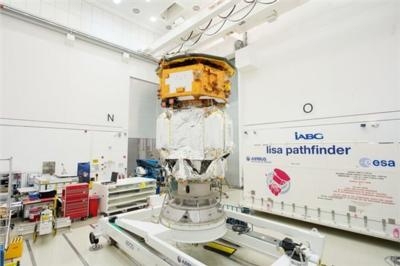Scheduled For Launch From French Guiana Later This Year
LISA Pathfinder, ESA’s demonstrator for spaceborne observations of gravitational waves, is ready to leave for Europe’s Spaceport in Kourou, French Guiana.

Scheduled for launch on a Vega rocket later this year, the spacecraft was on display today at IABG’s test center in Ottobrunn, near Munich, Germany, where final integration and extensive tests were performed over the past few months. This was the last chance for scientists, engineers and members of the media to see LISA Pathfinder before it is packed for shipping. “This is an extremely challenging mission that will pave the way for future space-based projects to observe gravitational waves, opening a new window to explore the cosmos,” said Paul McNamara, ESA’s project scientist.
Gravitational waves are ripples in the fabric of spacetime produced by accelerating massive bodies, such as a pair of orbiting black holes. Predicted by Albert Einstein’s general theory of relativity in 1915, they are expected to be ubiquitous in the Universe, but have not been directly detected to date.
While ground-based searches for these elusive messengers of gravity have been under way for the past few decades, a gravitational-wave observatory in space would open up new possibilities in this quest. LISA Pathfinder will test the fundamental technologies and instrumentation needed for such an observatory, demonstrating them for the first time in space. “Gravitational waves are an entirely fresh and different way to study the Universe, providing an important complement to the well-established approach of astronomy, based on observing the light emitted by celestial bodies,” says Paul.
Among the anticipated sources of gravitational waves are supernova explosions and double black holes. These objects are thought to be associated with overwhelmingly powerful events. For example, the energy released in gravitational waves during the last few minutes of the merging of just one pair of supermassive black holes is comparable to the total energy emitted as light by all stars and galaxies across the cosmos over the same time.
Scientists are also looking forward to discovering even more, unexpected cosmic sources once they are able to ‘listen’ to the Universe on this new channel. “But we're not quite there yet, and this is where LISA Pathfinder steps in,” says César García Marirrodriga, ESA’s project manager.

Despite the enormous energy release in gravitational waves produced by these mighty cosmic events, they should only cause tiny perturbations to the fabric of spacetime. Instruments built to detect them must be capable of making exquisitely precise measurements of extremely small changes in distance between two reference objects.
Typically, for a space-based gravitational wave observatory, this will mean seeing the distance between two ‘test masses’ separated by around a million kilometres changing by about a millionth of a millionth of a meter. This requires extraordinary measurement techniques using lasers, with the test masses flying freely in space, each shielded by a surrounding spacecraft from all extraneous influences, such as the solar wind.
LISA Pathfinder will test those crucial underlying technologies in a single spacecraft, with the two test masses separated by only 15 inches. The aim is to prove that the masses can fly through space, untouched but shielded by the spacecraft, and maintain their relative positions to the precision needed to realise a full-up gravitational wave observatory later.
“The extreme precision of measurements and control required in this domain pose a great technical challenge,” says Cesar. “In fact, everything was a challenge in this brand-new class of missions: from the innovative instrumentation, to the new modelling of self-gravitation within the spacecraft, and the very complex integration tests of the spacecraft. “The industrial and scientific teams that undertook these daunting tasks have done an extraordinary job, and now the mission is ready for launch.”
After ascent on the Vega rocket, LISA Pathfinder will enter an elliptical orbit around Earth, where it will use its own propulsion system to raise the high point of its orbit. Eventually, after about eight weeks, the spacecraft will reach its operational orbit around the Lagrange point L1, just under a million miles from Earth towards the Sun. There, LISA Pathfinder will begin six months of demonstrating the technology for future gravitational-wave observatories in space.
“We’ve made great progress with LISA Pathfinder in the past decade and are very excited to be so close to operating this incredible physics laboratory in space,” concludes Paul.
(Images provided by ESA)
 Unfortunate... ANN/SportPlane Resource Guide Adds To Cautionary Advisories
Unfortunate... ANN/SportPlane Resource Guide Adds To Cautionary Advisories ANN FAQ: Turn On Post Notifications
ANN FAQ: Turn On Post Notifications ANN's Daily Aero-Term (04.29.24): Visual Approach Slope Indicator (VASI)
ANN's Daily Aero-Term (04.29.24): Visual Approach Slope Indicator (VASI) ANN's Daily Aero-Term (04.28.24): Airport Marking Aids
ANN's Daily Aero-Term (04.28.24): Airport Marking Aids ANN's Daily Aero-Linx (04.28.24)
ANN's Daily Aero-Linx (04.28.24)




